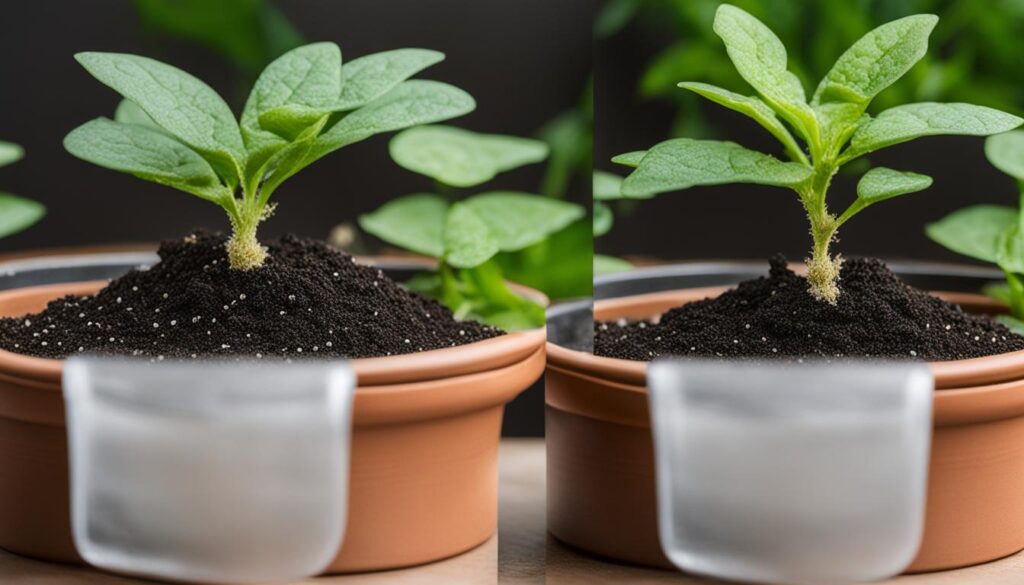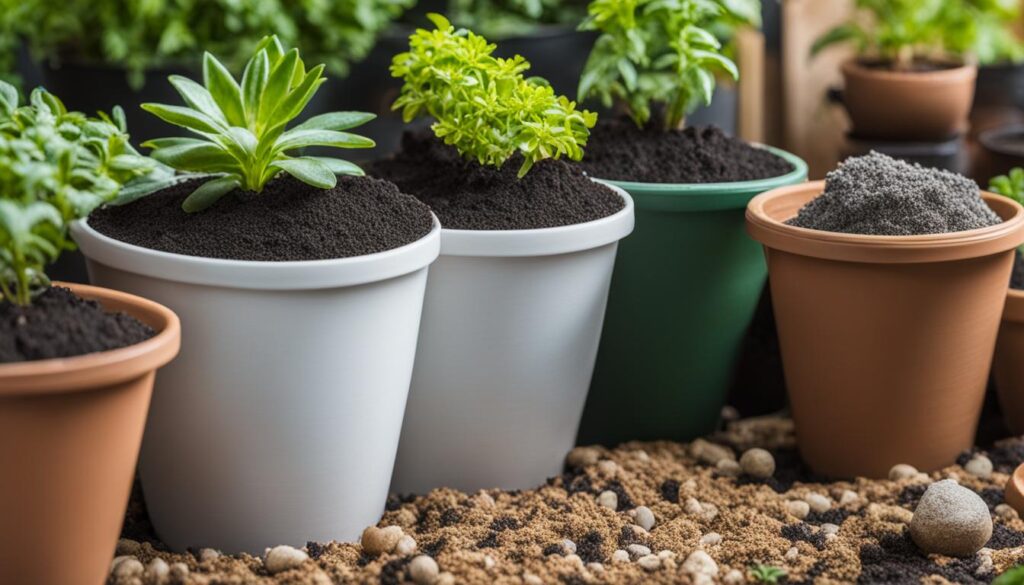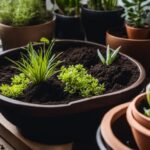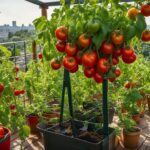What is Perlite vs. vermiculite, Uses, Differences, Pros, and cons, and When to Use and Avoid them
Perlite and vermiculite are two commonly used soil additives in gardening. While they share some similarities, they have distinct characteristics and uses. In this article, I will compare perlite and vermiculite, discuss their uses, highlight their differences, and provide tips on when to use each and when to avoid them.

Key Takeaways:
- Perlite and vermiculite are soil additives commonly used in gardening
- Perlite improves drainage and aeration, while vermiculite retains moisture and nutrients
- Perlite is ideal for loosening heavy soil, repotting plants in drier conditions, and gardening in wet climates
- Vermiculite is suitable for seed starting, potting plants that dry out quickly, and gardening in dry climates
- Both perlite and vermiculite can be used in organic gardening
Characteristics of Perlite vs. Vermiculite
When it comes to gardening, perlite and vermiculite are two popular soil additives with distinct characteristics. While they share similarities, they each offer unique benefits for plant growth and cultivation.
Perlite is best suited for loosening heavy soil and providing optimal drainage, making it ideal for plants that require well-draining soil. On the other hand, vermiculite excels in retaining moisture and nutrients, making it a great choice for plants that prefer constant moisture.
Perlite vs. Vermiculite Characteristics Comparison:
| Perlite | Vermiculite |
|---|---|
| Loosens Heavy Soil | Retains Moisture and Nutrients |
| Provides Drainage | Acts as a Sponge to Absorb Water |
| Enhances Aeration in the Soil | Improves Soil Structure |
| Lightweight and Porous | Facilitates Seed Germination |
| Approved for Organic Gardening | Approved for Organic Gardening |
Remember, the choice between perlite and vermiculite depends on the specific needs and preferences of your plants. Consider the characteristics and benefits of each to optimize your gardening results.
What is Perlite?
Perlite is a white, porous, lightweight rock made by heating volcanic glass until it expands and “pops” into small Styrofoam-like balls. It is commonly used in gardening as a soil additive to improve drainage, provide oxygen to plant roots, and enhance soil structure.
Perlite offers several uses in gardening. Its lightweight nature allows it to improve soil aeration, preventing compaction and creating space for plant roots to grow. Additionally, perlite aids in water drainage, preventing waterlogging and the potential for root rot.
One of the main uses of perlite is in seed starting. Its porous nature provides an ideal environment for young seedlings, allowing them to establish strong root systems. Perlite is also commonly blended into potting mixes to improve their structure and provide optimal growing conditions for plants.
Furthermore, perlite is ideal for repotting houseplants or plants that prefer drier conditions. It helps create well-draining soil, ensuring that excess moisture doesn’t accumulate around the plant’s roots.
To summarize, perlite is a versatile soil additive with uses ranging from seed starting to potting mix blending. Its ability to improve drainage and soil structure makes it a valuable tool for gardeners looking to create optimal growing conditions for their plants.
Benefits of Perlite in Gardening:
- Improves soil drainage
- Enhances soil aeration
- Prevents compaction
- Creates space for plant roots
- Aids in seed starting
- Blends well with potting mixes
- Provides optimal conditions for plants
What is Vermiculite?
Vermiculite is a naturally occurring mineral that expands when heated. It comes in the form of small golden-brown flakes and is used in gardening as a soil additive to improve moisture retention.
One of the unique properties of vermiculite is its ability to absorb up to four times its weight in water. This makes it an excellent choice for plants that require a moist growing environment. When added to the soil, vermiculite creates air pockets that allow for improved water and nutrient absorption by plant roots.
In addition to its water-holding capacity, vermiculite also acts as a sponge, absorbing and storing key nutrients for plants. This can help ensure that plants have a steady supply of essential elements for healthy growth.
Vermiculite is commonly used in various gardening applications. It is often used for potting up plants that require moist compost, such as tropical plants or those that thrive in humid conditions. Vermiculite is also a popular choice for starting seeds, as it provides a suitable medium for germination and helps maintain consistent moisture levels.
Furthermore, vermiculite is beneficial for potting on seedlings, as it helps anchor their delicate root systems and provides ample moisture to support their growth.
To summarize, vermiculite is a versatile soil additive that improves moisture retention and nutrient absorption for plants. Its ability to retain water and store nutrients makes it particularly useful for potting up plants that require a moist growing environment, starting seeds, and potting on seedlings.
Difference Between Perlite and vermiculite
When it comes to perlite vs. vermiculite, understanding their differences is essential in determining the best soil additive for your gardening needs. While both perlite and vermiculite serve similar purposes and are suitable for organic gardening, they exhibit distinct characteristics that set them apart.
Perlite, as an aerator, excels in improving soil drainage and aeration. It consists of lightweight, white, porous, and expanded volcanic glass particles, resembling small Styrofoam balls. When added to soil or potting mixes, perlite prevents waterlogging and allows excess moisture to drain, keeping the root zone well-ventilated.
Vermiculite, on the other hand, acts more like a sponge, retaining moisture and nutrients within the soil. This naturally occurring mineral, in the form of golden-brown flakes, has the remarkable ability to absorb and hold up to four times its weight in water. By retaining moisture and nutrients, vermiculite promotes healthy plant growth and helps prevent drying out, particularly in porous containers or dry climates.
| Perlite | Vermiculite |
|---|---|
| Improves soil drainage | Retains moisture and nutrients |
| Aerates the soil | Acts as a sponge |
| Prevents waterlogging | Helps prevent drying out |
Choosing between perlite and vermiculite depends on your desired soil conditions and the specific needs of your plants. If you need to improve drainage and aeration, perlite is your go-to choice. Conversely, if you want to retain moisture and nutrients or prevent drying out, vermiculite is the ideal option.
By understanding the differences between perlite and vermiculite, you can make informed decisions when selecting the right soil additive to enhance your gardening experience.
When to Use Perlite
Perlite is a versatile soil additive that offers numerous benefits in gardening. Understanding when to use perlite and how it can enhance your plants’ growth is key to successful gardening. Here are the top scenarios where perlite can be incredibly useful:
Loosening Heavy Clay Soil
If you have heavy clay soil that tends to become compacted and drain poorly, perlite can be a game-changer. By adding perlite to your soil, you can create air pockets that improve its drainage and aeration. This allows the roots to breathe and prevents waterlogging, leading to healthier plants.
Repotting Houseplants or Plants That Prefer Drier Conditions
When repotting houseplants or plants that thrive in well-draining soil, such as succulents and cacti, adding perlite to the potting mix is highly beneficial. Perlite aids in creating a light, well-draining medium that helps prevent water retention and potential root rot. It promotes healthier root growth and better overall plant health.
Gardening in a Wet or Humid Climate
In wet or humid climates, excess moisture in the soil can be a challenge for many plants. Perlite acts as a natural drainage aid, preventing water from accumulating and causing root problems. By incorporating perlite into containers or garden beds, you can effectively improve drainage and prevent waterlogging.
Plants Prone to Root Rot or Fungal Diseases
Some plants are more susceptible to root rot or fungal or several diseases, especially when their roots are constantly sitting in damp soil. Perlite’s ability to enhance soil drainage and aeration can significantly reduce the risk of these issues. By adding perlite to the soil, you create an environment that discourages the growth of harmful pathogens and promotes healthy root development.
If you find yourself in any of these situations, incorporating perlite into your gardening routine can bring significant benefits to your plant’s health and growth.
Benefits of Perlite in Gardening
- Improves soil drainage
- Prevents waterlogging
- Aids in root aeration
- Reduces the risk of root rot and fungal diseases
When to Use Vermiculite
Vermiculite is a versatile soil additive that offers numerous benefits for gardening enthusiasts. Whether you’re starting seeds or repotting plants, incorporating vermiculite can greatly enhance your gardening experience. Here are some situations where vermiculite proves particularly useful:
1. Starting Seeds
When it comes to seed starting, vermiculite is a great companion. Its moisture retention properties create an optimal environment for germination. The fine texture of vermiculite promotes root growth and ensures that seeds have consistent access to water, setting the stage for healthy seedlings.
2. Repotting Outdoor Container Plants
If you have outdoor container plants that tend to dry out quickly, vermiculite is here to help. Its ability to retain moisture makes it an excellent additive for porous containers. By incorporating vermiculite into the potting mix, you can create a more favorable moisture balance and prevent your plants from drying out.
3. Gardeners in Dry Climates
Gardeners in dry climates face the challenge of conserving moisture within the growing media. Vermiculite is an ideal solution for these environments. Its moisture retention capabilities help prevent excessive evaporation, ensuring that plants have a constant water supply. By using vermiculite, you can maintain optimal soil moisture levels, promoting healthy and thriving plants.
So, whether you’re starting seeds, repotting outdoor container plants, or dealing with dry climates, adding vermiculite to your gardening routine can provide significant benefits. It’s a versatile tool for increasing moisture retention and creating an ideal growing environment for your plants.
Can You Use Perlite or Vermiculite in Organic Gardening?
In organic gardening, many gardeners wonder if they can use perlite or vermiculite as soil additives. The good news is that both perlite and vermiculite are considered safe and approved for use in certified organic agriculture. They are naturally mined minerals that undergo physical processing but maintain their organic status. This means that you can confidently use perlite and vermiculite in organic gardening without any concerns.
Perlite and vermiculite offer unique benefits that make them valuable additions to organic gardening practices. Let’s take a closer look at how these minerals can be used:
| Perlite | Vermiculite |
|---|---|
| Improves soil drainage | Retains moisture and nutrients |
| Loosens heavy clay soil | Helps plants in drying conditions |
| Provides oxygen to plant roots | Absorbs water and nutrients |
As you can see, perlite is excellent for improving soil drainage and oxygenation, making it suitable for plants that require well-aerated soil. On the other hand, vermiculite excels in retaining moisture and nutrients, making it ideal for plants that prefer consistent moisture or grow in drier conditions.
In organic gardening, utilizing perlite and vermiculite can help create an optimal growing environment for your plants while maintaining the integrity of organic practices. Whether you need to improve drainage or enhance moisture retention, perlite, and vermiculite can be valuable tools in your organic gardening toolkit.

Can You Grow Plants in Just Vermiculite?
When it comes to growing plants, vermiculite can be a versatile and effective option as a standalone growing medium. This mineral has unique properties that make it ideal for certain types of plants, especially seedlings that require constant moisture without being oversaturated. Let’s explore the benefits of using vermiculite as a growing medium and how it can be used effectively.
- Water-Holding Capacity: Vermiculite has excellent water retention capabilities, thanks to its ability to absorb and hold moisture. This is especially beneficial for seedlings during the critical germination phase. The water-holding capacity of vermiculite promotes faster and more successful germination, ensuring that your plants get off to a healthy start.
- Promotes Root Growth: Another advantage of vermiculite is its ability to anchor young root systems. The lightweight and porous texture of vermiculite allows roots to penetrate easily and establish themselves, creating a sturdy foundation for plant growth. This is particularly important for delicate and young seedlings.
- Using vermiculite as a growing medium offers flexibility. It can be used alone or in combination with other materials, such as soil or other soilless mixes, depending on the specific needs of your plants. Vermiculite provides an airy and well-drained environment for root development, preventing waterlogging and promoting healthy growth.
Advantages of Growing Plants in Vermiculite
- Excellent water-holding capacity for faster germination
- Promotes strong root development and anchoring
- Flexible usage – can be used alone or mixed with other materials
If you decide to grow plants in vermiculite alone, it’s important to note that while vermiculite provides moisture retention, it cannot provide essential nutrients. Therefore, you may need to supplement with fertilizers or nutrient solutions to ensure your plants receive a balanced diet. Additionally, vermiculite is not suitable for all types of plants, particularly those that prefer well-drained or dry conditions.
Now that you know the advantages of using vermiculite as a growing medium, you can confidently experiment with this versatile material in your gardening endeavors. Whether you’re starting seedlings indoors or potting plants that require constant moisture, vermiculite can be your go-to growing medium for healthy and thriving plants.
Can You Mix Perlite and Vermiculite?
Yes, you can mix perlite and vermiculite in your seed-starting mix or potting mix. Each ingredient serves a different function, with perlite improving drainage and vermiculite enhancing moisture retention. When used in combination, perlite and vermiculite provide the perfect balance of drainage and water retention for your soil.
Perlite, with its lightweight and porous nature, helps to create air pockets in the soil, promoting excellent drainage. It prevents soil compaction and allows excess water to drain away, preventing waterlogging and root rot. On the other hand, vermiculite can absorb and retain moisture, providing a constant source of water to plants and reducing the risk of plants drying out between watering.
| Perlite | Vermiculite |
|---|---|
| Improves drainage | Enhances moisture retention |
| Prevents soil compaction | Helps prevent plants from drying out |
| Promotes aeration | Provides constant moisture supply |
When mixing perlite and vermiculite, start with equal parts of each ingredient in your potting mix. Adjust the ratio according to your specific needs and the requirements of your plants. The combined benefits of perlite and vermiculite make it an excellent choice for improving the overall structure and moisture management of your soil.
Using Perlite and Vermiculite Together: Tips and Considerations
- Use a high-quality perlite and vermiculite mix from reputable brands.
- Consider the water needs of your plants and adjust the ratio accordingly. Increase the amount of vermiculite for plants that require more moisture, and increase the amount of perlite for plants that need better drainage.
- Ensure thorough mixing of perlite and vermiculite to distribute the particles evenly throughout the soil.
- Monitor the moisture levels of your soil regularly to avoid overwatering or underwatering.
- Remember to adjust your watering frequency and amount based on the water retention properties of the mixture.
Where to Buy Perlite and Vermiculite
If you’re looking to purchase perlite and vermiculite for your gardening needs, you’ll find them readily available at garden centers, nurseries, and online stores. These versatile soil additives come in various grades and sizes, catering to different gardening requirements.
Whether you prefer to shop in person or online, there are plenty of options to choose from. Visiting a local garden center or nursery allows you to see the products firsthand and seek advice from knowledgeable staff. Online stores, on the other hand, provide convenience and a wide range of choices at the click of a button. Whichever method you choose, ensure that you source your perlite and vermiculite from trusted suppliers to ensure the best results for your plants.
FAQ
What are the differences between perlite and vermiculite?
Perlite and vermiculite have different characteristics and uses. While both are soil additives commonly used in gardening, perlite is best for improving drainage and loosening heavy soil, while vermiculite excels at retaining moisture and nutrients.
When should I use perlite?
Perlite is ideal for use when you want to loosen heavy clay soil, repot houseplants or plants that prefer drier conditions, or when gardening in a wet or humid climate. Adding perlite to containers or garden beds helps improve drainage and prevent waterlogging.
When should I use vermiculite?
Vermiculite is recommended for use when starting seeds, as it helps retain moisture and provides a suitable medium for germination. It is also useful for repotting outdoor container plants that dry out quickly, especially in porous containers. Vermiculite is beneficial in dry climates as it conserves moisture in the growing media.
Can I mix perlite and vermiculite in my soil?
Yes, you can mix perlite and vermiculite in your seed-starting mix or potting mix. Each ingredient serves a different function, with perlite improving drainage and vermiculite enhancing moisture retention. The combination of perlite and vermiculite provides the right balance of drainage and water retention for your soil.
Are perlite and vermiculite safe to use in organic gardening?
Yes, both perlite and vermiculite are considered safe and approved for use in certified organic agriculture. They are natural mined minerals that go through physical processing but maintain their organic status. Therefore, they can be used in organic gardening without any concerns.
Can I grow plants in just vermiculite?
Vermiculite can be used as a growing medium on its own, especially for seedlings that require constant moisture without being oversaturated. Its water-holding capacity promotes faster germination and helps anchor young root systems. Vermiculite can be used alone or as part of soil or soilless mixes for indoor seed starting.
Where can I buy perlite and vermiculite?
Perlite and vermiculite can be found in garden centres or nurseries, as well as online. Reputable brands offer different grades and sizes of perlite and vermiculite. It is recommended to choose reputable brands and suppliers for quality products.




